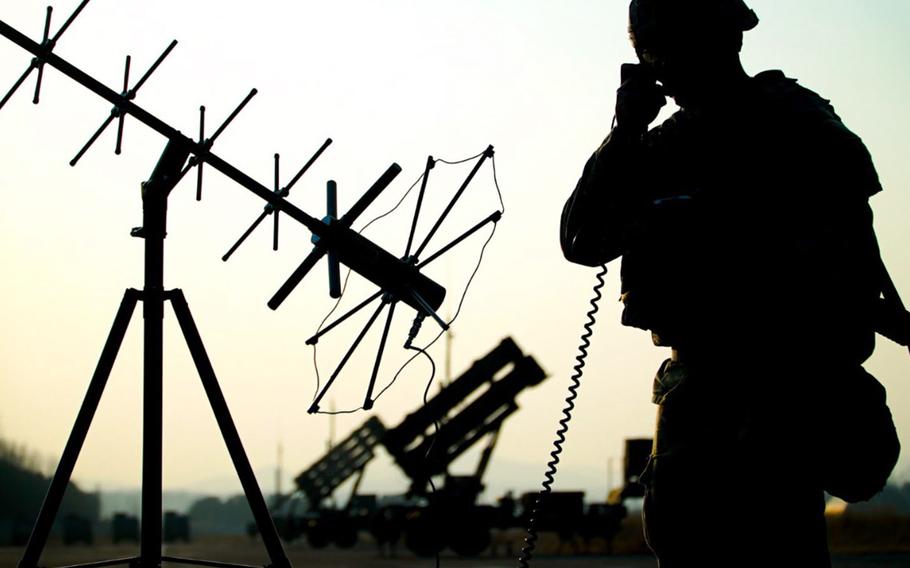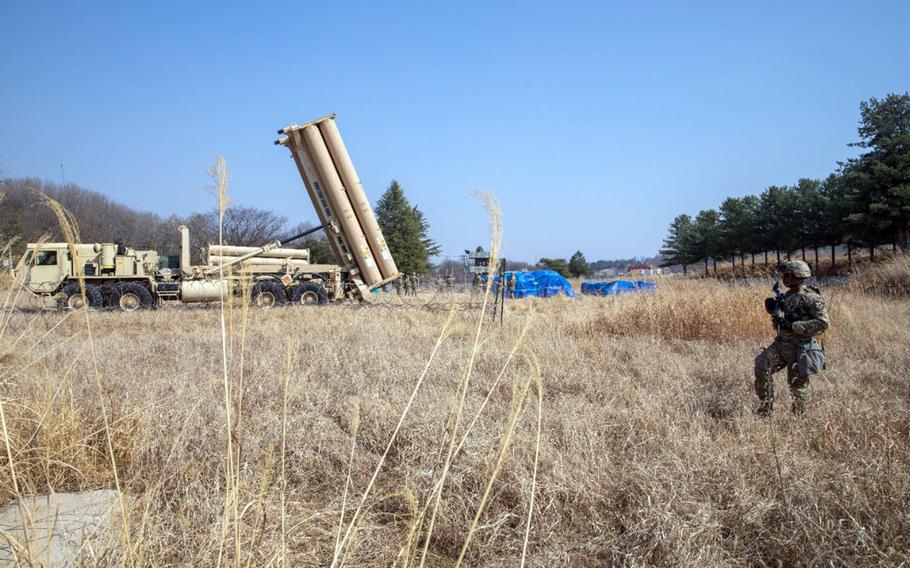
A U.S. soldier assigned to the 35th Air Defense Artillery Brigade talks to his headquarters during the Freedom Shield exercise in South Korea, March 19, 2023. (Josephus Tudtud/U.S. Army)
CAMP HUMPHREYS, South Korea — U.S. troops in South Korea remotely fired their top-shelf missile-defense system for the first time during a large-scale military exercise, according to U.S. Forces Korea.
U.S. troops in “deployment training” employed the remote launcher for the Terminal High Altitude Area Defense, or THAAD, anti-missile system, the command said in a news release Friday.
“In the face of [North Korea’s] advanced missile threats, the training of our THAAD forces enhanced the units’ combat readiness, combined defense posture within the alliance, demonstrates the ironclad commitment to support and defend [South Korea] and further strengthens the security and stability on the Korean Peninsula,” the release said.
The THAAD remote kit allows the missile interceptor more siting options and increases the area it can defend, according to a Lockheed Martin news release from 2019.

Spc. Najuusah Mulbah of the 2nd Stryker Brigade Combat Team patrols the perimeter of a Terminal High Altitude Area Defense, or THAAD, missile-defense system in South Korea, March 19, 2023. (Gregory Menke/U.S. Army)
USFK did not respond to repeated requests for comment about whether THAAD interceptors were actually launched during the drill, and the dates and location of the training.
The THAAD drill happened in conjunction with the Freedom Shield exercise by U.S. and South Korean forces, according to the release. The 11-day exercise that ended Thursday focused on simulations and included personnel from U.N. Command and the Combined Forces Command.
U.S. and South Korean troops have been conducting their largest exercises in years across the country this month.
Around 1,200 soldiers from the U.S. 2nd Infantry Division and South Korean army on Thursday wrapped up live-fire training in Pocheon, just 16 miles from the Demilitarized Zone. Meanwhile, 5,500 U.S. sailors and Marines from the Makin Island Amphibious Ready Group arrived in Busan on Wednesday ahead of a separate naval exercise scheduled later this month.
The $800 million THAAD system produced by Lockheed Martin was deployed to a South Korean base in Seongju, about 130 miles south of Seoul, to focus “solely on North Korean nuclear and missile threats,” the Defense Department said in June 2016.
Since then, the THAAD system has undergone several upgrades for “better performance” and for “improving interoperability” between it and the Patriot missile-defense system, South Korea’s Ministry of National Defense said in October.
Interoperability is a term used by the military to illustrate the ability of one nation’s military to use another’s training methods and equipment.
North Korea’s state-run website, Uriminzokkiri, in a blog post March 17 described the recent joint drills as a rehearsal for an “occupation of Pyongyang” that would prompt a “preliminary nuclear war.”
The communist regime has fired nine ballistic missiles so far this year, including one that flew toward the East Sea, or Sea of Japan, hours before South Korean President Yoon Suk Yeol met with Japanese Prime Minister Fumio Kishida in Tokyo.